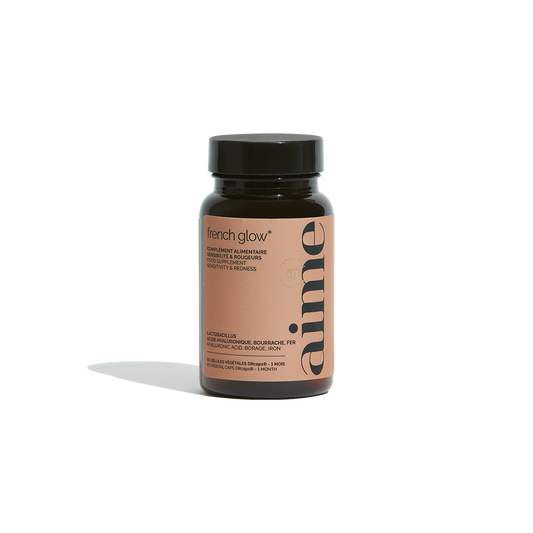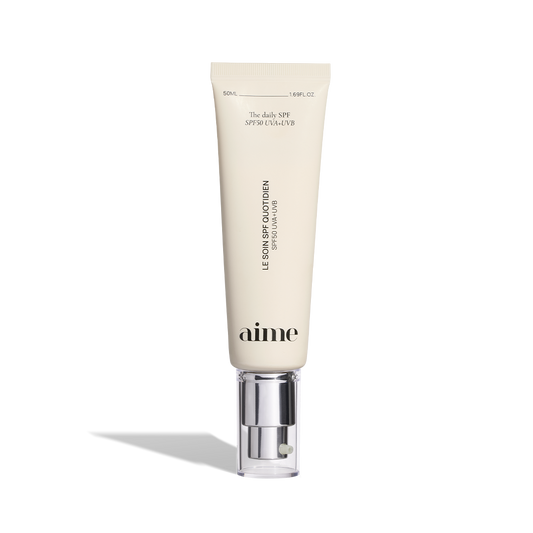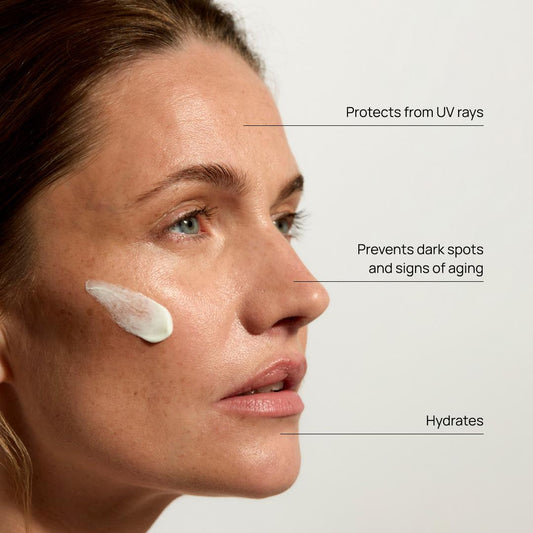Rosacea Treatment: How to Take Care of Your Skin?

What is rosacea?
Rosacea is a dermatological disease . This skin condition affects the blood vessels of the face. It occurs more frequently in people with fair skin, particularly adult women. Beyond the physical discomfort it causes, the repercussions are also psychological and have an effect on the relationship with one's own image and the way others see it. Very often, we try to camouflage the symptoms of this type of skin problem as much as possible ( redness , inflammation of the face) before understanding the causes and making changes to our routine. Rosacea is a pathology that can take several forms and which alternates between phases of flare-ups and remissions.
Vascular rosacea or couperose
Vascular rosacea or couperose is the most common type of rosacea. It is characterized by permanent redness in the center of the face (cheeks, nose, forehead and chin) avoiding the area around the eyes and mouth. This redness is often accompanied by heightened sensitivity of the skin . In the case of vascular rosacea, the cells of the epidermis are disjointed and the vessels of the dermis are irregular and dilated.
The structure of the skin
The skin is a protective envelope structured in 3 layers:
- The epidermis
The epidermis is the outermost layer of the skin that protects it from external aggressions. It contains the nerve endings that make the skin sensitive to touch.
- The dermis
The dermis is located beneath the epidermis. It is supplied with blood vessels that nourish the epidermis and houses hair follicles and sebaceous glands that secrete sebum. The main cells of the dermis synthesize:
- Collagen: makes the skin resistant and allows healing
- Elastin: makes the dermis supple and stretchy
- The hypodermis
The hypodermis is the deepest and thickest layer of the skin. It is composed of fat cells.
Couperose is a form of rosacea marked by the development of small, very fine, red and sometimes purplish blood vessels just below the surface of the skin. It also causes flushing and swelling of the center of the face in people with rosacea.
Causes and aggravating factors of rosacea
Rosacea is a disease that generally appears in adult women. Certain elements are recognized as the source of the pathology:
- Abnormal functioning of blood vessels
This dysfunction causes stagnation of blood in the vessels of the face which leads to dilation of the vessels, even edema and alteration of the endothelium (membrane which covers the inside of the veins of the face).
- Genetic predisposition
Rosacea is a disease more common in people with fair skin, light eyes and light hair.
Other factors that can worsen rosacea include:
- Demodex folliculorum
Demodex folliculorum is a parasite that feeds on sebum and colonizes the face. If present in excess in a single follicle, this mite can cause infection or inflammation such as rosacea.
- Food and alcohol
Alcohol and certain foods (spicy foods, hot drinks, etc.) accelerate the progression of the disease. We now realize that our diet plays a major role in our body, and therefore also in our skin. It is important to understand this connection in order to take action.
- Climatic factors
Exposure to wind, cold, sun or more generally any sudden thermal shock can aggravate skin problems such as rosacea.
- Strong emotions and stress
We know that the emotions that drive us can also have a direct impact on our external appearance.
How to treat rosacea naturally?
Before rushing to the stores or online to buy treatments and cosmetics that will cover up or treat the symptoms of your facial redness and inflammation, look into the underlying causes of the condition. Rosacea can indicate a gut problem or food intolerance . Learn to listen to your body! You can take tests to find out which foods are causing digestive problems.
Certain foods promote an imbalance in the microbiota and therefore the production of inflammatory molecules in the body which will notably cause/aggravate skin problems such as rosacea.
The microbiota is a group of bacteria present in different places in our body (in the digestive system, on the skin, in the vagina, etc.). Its balance is essential and beneficial for the health of the skin, but also of the nails, hair, etc.
An unbalanced diet disrupts the intestinal microbiota, which can no longer remove waste from the body. If toxins accumulate, it will show on the skin: redness, spots, dull complexion, etc.
A healthy and balanced diet
Eating a balanced diet is essential for maintaining good health. Digestive dysfunction is also known to be a common cause of skin problems. Modify or supplement your diet to provide your body with everything it needs. You can add to your shopping list:
- Fermented foods (kefir, tempeh, miso, kimchi, etc.)
Fermentation keeps good bacteria alive, which will provide natural probiotics to the intestinal microbiota.
Probiotics: live microorganisms that are beneficial to health if ingested in sufficient quantities. They are recognized as important in rebalancing intestinal flora.
- Olive oil
Olive oil is rich in monounsaturated fatty acids. It reduces inflammation and oxidative stress (imbalance between free radicals and antioxidants).
- Apple cider vinegar
Apple cider vinegar aids digestion and helps renew intestinal flora.
- Garlic
Garlic has anti-inflammatory and antiseptic properties.
- Artichokes, Jerusalem artichokes and bananas
They contain prebiotics which feed probiotics (good bacteria) and allow their growth.
When eating, it's important to take the time to chew your food thoroughly and not eat too quickly. Vary the foods you cook for a diverse and balanced diet. Remember to stay hydrated daily with water and herbal teas. Getting enough sleep and managing stress will also contribute to the good health of your body and, therefore, your skin.
Food supplements
A balanced diet isn't always enough, and you may be lacking certain nutrients. To help with this, you can take dietary supplements . Dietary supplements, as the name suggests, complement a balanced diet. They don't replace a healthy diet, but they do provide an additional source of vitamins, minerals, and other active ingredients . They are available for a variety of conditions and conditions.
When dealing with skin problems like rosacea, taking anti-rosacea food supplements can be particularly beneficial. We have designed a formula rich in fatty acids that will soothe and rebalance the epidermis from the inside. French Glow is an anti-rosacea food supplement that reduces redness and makes the complexion brighter. This is possible thanks to a supply of probiotics that maintains the balance of the microbiota . French Glow is composed of borage oil (for hydration and elasticity of the skin) in combination with plant-based hyaluronic acid , Eschscholzia Californica poppy flower extract (anti-stress and soothes inflammation) and alpha lipoic acid (antioxidant that acts against skin aging).
The effects of taking dietary supplements on the skin can appear after 3 months to 1 year. Initially, the skin will purge itself and therefore imperfections will appear. This process is completely natural; you have to be patient.
Good to know: when the intestinal barrier is weakened, it allows unwanted molecules to pass into the body, which can create inflammation and disrupt the assimilation of nutrients... and therefore the active ingredients in your supplements. Supplementing with L-Glutamine can be decisive in optimizing the absorption of active ingredients, for more visible, deeper, and longer-lasting results. The right thing to do? Consider taking a course of Barrier+™ for 15 days to 1 month at the start of your French Glow treatment to amplify its benefits.
A simple and effective skincare routine
To treat your skin, there's no point in using a multitude of cosmetic products and creams of all kinds. Use products that are suited to your skin type and limit yourself to what's necessary:
- A cleaner
- An antioxidant serum
- An eye contour treatment
- A moisturizer
- SPF protection
- A lip balm
Cleanse your face morning and night with a gentle soap to remove impurities. Apply your antioxidant serum to fight the inflammation caused by rosacea. Moisturize your skin and lips properly to prevent drying out, and protect your skin from UV rays with sunscreen.
Occasionally, once or twice a week for example, you can exfoliate with a grain-free exfoliant and leave on a mask suited to your skin . Not all skin types require the same treatment.
If problems persist, don't hesitate to consult your doctor or a dermatologist for a diagnosis. Our advice does not constitute a prescription. A dietary supplement is not a medicine and does not cure any condition.
Cited in this article


Redness and sensitivity supplement, French Glow





